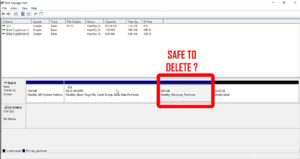We had a client with an odd partition configuration. As you can see in the screen shot to the right, the recovery partition appears after C: drive volume with data on it.
The question is, it is safe to delete the Recovery Partition to all the C:\ to be easily expanded?
What Is A Recovery Partition?
Microsoft started incorporating recovery partitions with the release of Windows 8 in Server 2012 r1. These partitions are designed to help users restore their systems to a previous state in case of issues. They contain tools and data necessary for system recovery, making it easier to troubleshoot and fix problems without needing external media.
What Happens If Files Are Needed From The Recovery Partition?
If your system lacks a recovery partition and you need to perform a recovery or reset, it will likely prompt you to insert a Windows installation DVD or USB drive.
Can The Recovery Partition Be Safely Deleted?
Yes, it’s safe to delete the recovery partition on a Windows client or server to expand the C: drive.
Deleting the recovery partition on a Windows Server can free up some space, but it comes with potential risks. The recovery partition is used for system recovery and troubleshooting, so removing it could make it harder to restore your system if something goes wrong, but as noted the system will likely prompt for the installation DVD.
If you decide to delete it, make sure you have a recent backup of your server. You can use tools like Disk Management or third-party partition management software to delete the recovery partition and extend the C: drive
Will a VMWare Snapshot Recreate a Deleted Partition?
Yes, VMware snapshots do keep track of the state of a virtual machine, including its virtual disks, at the time the snapshot is taken. This means that if you damage or delete a partition, you can revert to a previous snapshot to restore the virtual machine to its state at the time the snapshot was taken, effectively recovering the partition and its data.
However, it’s important to note that snapshots are not a substitute for regular backups. They are intended for short-term use, such as testing or making temporary changes, and can impact performance if used for long periods. For long-term data protection, it’s best to use a dedicated backup solution.




0 Comments